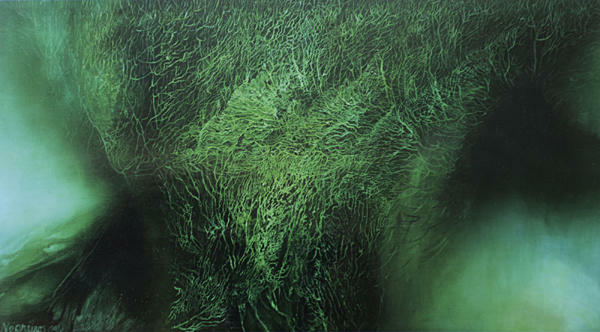María Thereza Negreiros
The Patricia & Phillip Frost Art Museum, Miami
Perhaps one of the most controversial careers in Latin American avant-garde is that of Colombian-Brazilian artist María Thereza Negreiros (Maués, 1930); her itinerary evolves in an unusual way in the artistic contemporary movement of the continent.

We could say that since her beginnings in the 1970s, when she conferred to abstract expressionism a temperament that pretends to advance beyond impressing the retina by invading the intellect, the painter has become the protagonist of important lateral explorations, keeping her distance from the clichés of modernity. She has shown it in her experiments with informalism, with the volumes and reliefs, and with the pioneering and experimental use of plastic and chemical alloys, as well as with her optic sculptures. The critics did not hesitate to highlight her innovative essentialities.
However, a personal turn in the artist’s life brought her creative motivations once again close to the exuberance of a medium from which she was never emotionally detached: the Amazonian rainforest. The return to cohabiting with deep nature reoriented her obsessions to the traditional roads from which she had departed, leading her to reside between pictorial renovation and conceptual probing.
Absorbed in a sort of ecological mystique, Negreiros has dedicated almost four decades of her life to resume painting of the forest, running counter wise to the evolution of technology and the objectualist cult, yet more experienced in aspirations and trade. It was an act of provocative reassessment which initially provoked surprise and even repeal. Yet her shrewdness in translating the naturist detail into throbbing metaphor through the emotions of color and the delicate solutions in the vicinities of blot and stroke, have made of this artist a spontaneous and exceptional counter-reformist.
Adriana Herrera and Francine Birbragher-Rozencwaig evoked the act of passion represented by going back on one´s steps without relinquishing the alternative gesture, to develop the thesis on which the exhibition “María Thereza Negreiros: Offerings”, currently held at The Patricia & Phillip Frost Art Museum, is grounded. The project attempts to show that the atypical curricular quality in Negreiros grows toward intellectual maturity in reverse sense to the logic of the contemporary avant-garde movement, and that contradicting the old-fashioned speculations of a certain historiography, it throws as a healthy balance that painting, in its most chaste manifestation, still contains sensitive proposals that make the spirit shudder and that clash with the hypothetical exhaustion of the discourse.
The curators attest to this on the basis of the wise selection of ten extremely well accomplished pieces displayed with meticulous organic quality. During what I can predict will be unavoidable stops, the viewer’s perception shall be captivated by the pictorial effects arising from the subjective improvisation. Inflammable color, depth and vibration are the crucial elements used by the artist to fuse with the jungle, take possession of the poetry of hidden water running in the thick forest and above all, to denounce the predatory action of man. In her canvases, the ecological intention surprises us by becoming a subject of social reflection supported by the expressive possibilities of color and by the dramatic quality added to the pictorial cover.
From this aesthetic-intimist starting point, Negreiros convinces us in a conclusive way of the fact that, irrespective of post-modern manifestos, painting can indeed work as an ideology. And the brave reaffirming of her origins is perhaps the most transgressive gesture of a trajectory which has deeply marked the continent´s conception of the image.
-
 Gran Igapo
Gran Igapo
-1996




